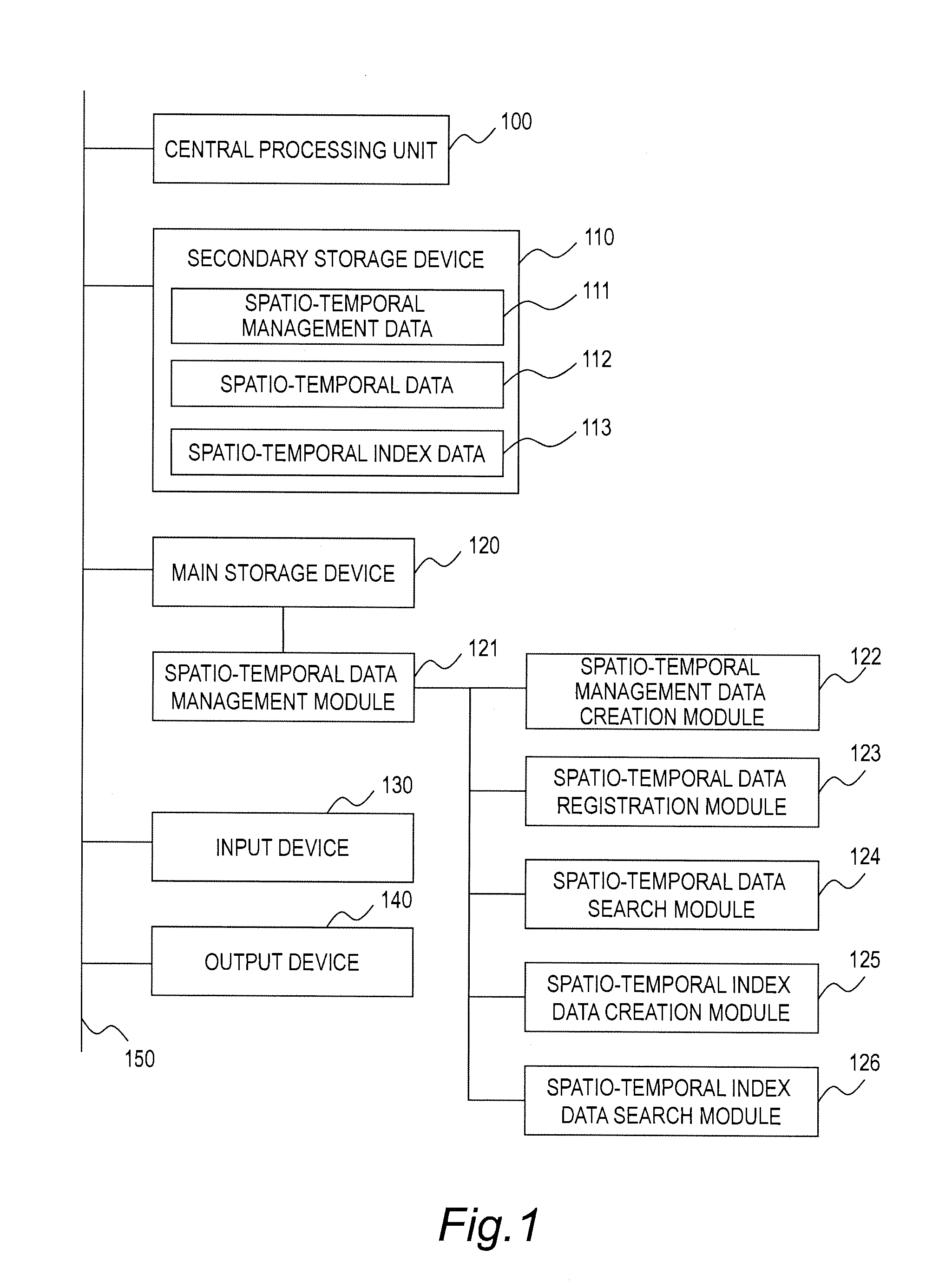Spatio-temporal data management system, spatio-temporal data management method, and program thereof
- Summary
- Abstract
- Description
- Claims
- Application Information
AI Technical Summary
Benefits of technology
Problems solved by technology
Method used
Image
Examples
first embodiment
[0049]FIG. 1 is a block diagram illustrating a hardware configuration of a spatio-temporal data management system according to a first embodiment of this invention.
[0050]The spatio-temporal data management system according to this embodiment is a computer including a central processing unit 100, a secondary storage device 110, a main storage device 120, an input device 130, and an output device 140, in which the central processing unit 100, the secondary storage device 110, the main storage device 120, the input device 130, and the output device 140 are connected via a bus 150.
[0051]The central processing unit 100 is a processor for executing programs stored in the main storage device 120.
[0052]The secondary storage device 110 is a non-volatile storage device having a large capacity, for example, a magnetic storage device or a flash memory, and stores data used by the central processing unit 100 at the time of executing the programs. To be specific, the secondary storage device 110 ...
second embodiment
[0144]Next, a second embodiment of this invention is described. In the second embodiment of this invention, a spatio-temporal data management system capable of processing point time series data is described.
[0145]FIGS. 17A and 17B are diagrams illustrating an example of the spatio-temporal data (point time series data) before registration to the spatio-temporal data management system according to the second embodiment of this invention.
[0146]FIGS. 17A and 17B exemplify the grid time series data of the two-dimensional space. The space range ranges from the lower left coordinates (0, 0) to the upper right coordinates (100, 100). Moreover, the start time of the grid time series data is t=0, and the cases of t=150 and t=300 are exemplified with the time period interval of 150. Moreover, for simplicity of description, the time and the coordinate values are expressed with simple integer values. In practice, for example, the time is expressed by year, month, date, hour, minute, and second ...
third embodiment
[0182]Next, a third embodiment of this invention is described. In the third embodiment of this invention, both grid time series data and point time series data may be processed, and intersection test processing for correlating both the data is performed.
[0183]FIGS. 25A and 25B are diagrams illustrating an outline of an intersection test for different kinds of spatio-temporal data according to the third embodiment of this invention.
[0184]In the intersection test for the spatio-temporal data, the grid time series data and the point time series data are correlated to determine whether the search conditions (temporal condition, spatial condition, and attribute condition) are satisfied.
[0185]To be specific, at the time of rough determination, as illustrated in FIG. 25A, the spatio-temporal ID (when a condition of an attribute value is specified, the attribute value MIN and the attribute value MAX) is used to extract the spatio-temporal segments of the grid time series data that are consi...
PUM
 Login to View More
Login to View More Abstract
Description
Claims
Application Information
 Login to View More
Login to View More - R&D
- Intellectual Property
- Life Sciences
- Materials
- Tech Scout
- Unparalleled Data Quality
- Higher Quality Content
- 60% Fewer Hallucinations
Browse by: Latest US Patents, China's latest patents, Technical Efficacy Thesaurus, Application Domain, Technology Topic, Popular Technical Reports.
© 2025 PatSnap. All rights reserved.Legal|Privacy policy|Modern Slavery Act Transparency Statement|Sitemap|About US| Contact US: help@patsnap.com



